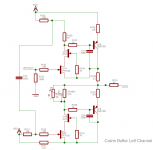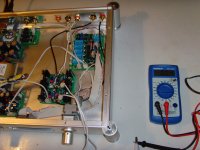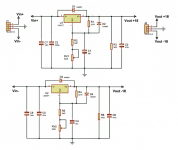Joshua,
Since I have a PCB, I can build one complete channel of the buffer, power it with +-18V and use sockets in all 4 locations for the FETs.
If I do this, how do I match the master devices?
Thanks...
It looks to me that matching masters for Idss in the actual circuit is impractical.
Building a jig shouldn't be a problem.
Using fig 5 of attached pdf
The schematic of the jig I posted above is based on Borbely's circuit.
Joshua, if I were to use matched 2SK170BL in the buffer, which resistors would need to be changed and to what values?
Most of my matched pairs are between 7.0-7.3mA Idss.
Thanks...
I don't know if any change is needed - and if it's needed - to what.
I will follow Andrew advice.
The advice you quoted doesn't refer to this particular question, it doesn't take into account the BJTs current flowing through the JFETs source resistors.
Hi,
simulating with BobCordells LSK389C model would give ~5.4mA for 20R.
The 2R2 in the Calvin Buffer simply result from the fact that the bipolar booster current adds to the JFET current.
As the bipolar Boosters add approxiamtely 45mA the resulting current through the source resistors is 50mA, or ~9 times the current through the non-boosted cascode.
Hence the resistor needs to be roundabout 1/9th in value for the same value of voltage drop.
This voltage drop equals the Vgs of the Master JFETs.
Btw: in #441 or #442 schematics all current values are noted
jauu
Calvin
Now?
I don't know if any change is needed - and if it's needed - to what.
Are you going to use the BL-grade 2SK170's in the Calvin buffer?
I guess I could go ahead and match some J107's(by Vgs) to the matched 2SK170's that I already have.
Then plug all of them into the board with sockets and see what happens.
My KSA1831's should be here Monday.
As the quote in Merlin's post above states, the current values are noted.
Maybe this could be helpful should anything need to be changed in order to use the K170's.
Are you going to use the BL-grade 2SK170's in the Calvin buffer?
Probably, possibly V grade.
I guess I could go ahead and match some J107's(by Vgs) to the matched 2SK170's that I already have.
...
Why not purchase some PN4391?
Why not purchase some PN4391?
I have both PN4391 and J107 to use as "slaves".
Trying to "match" these devices, by Idss using a 100 ohm resistor in series with the drain, results in inconsistent voltage readings due to them heating up very quickly.
That's why I was going to try to match them by Vgs using the single supply jig I posted above. That's seems to be the easiest part of this whole "matching" process.
The attached circuit recommends using a 10 ohm resistor when testing FET's with a Idss of 50mA or less.
I tried the circuit with the PF5102's that I have.
The PF5102's are rated between 4-20mA for Idss.
With a 15V supply, both the FET's and the 10 ohm resistor get hot FAST!😱
So that circuit doesn't seem to work, either.🙄
So...it's back to square one for me trying to "match" some "master" devices for this buffer.
At this point, I'm beginning to question whether this "matching" crap is worth the effort, or not.😡
Attachments
Last edited:
I have both PN4391 and J107 to use as "slaves".
If the masters are 2SK170, than PN4391 are preferred as slaves.
Trying to "match" these devices, by Idss using a 100 ohm resistor in series with the drain, results in inconsistent voltage readings due to them heating up very quickly.
Only masters are to be matched by Idss, not slaves.
That's why I was going to try to match them by Vgs using the single supply jig I posted above. That's seems to be the easiest part of this whole "matching" process.
The attached circuit recommends using a 10 ohm resistor when testing FET's with a Idss of 50mA or less.
…
The slaves are to be matched by Vgs AT THE ACTUAL DRAIN CURRENT OF THE WORKING BUFFER AND ONLY AT THAT CURRENT.
Hence, that jig and that method are not suited for the task at hand.
Once again:
1. For best results with this buffer, the masters are to be matched by Idss. This is very important. This can be done with a jig.
2. If possible, matching masters also by Vp is a benefit. This can also be done with a jig.
3. The buffer will work with unmatched slaves, though the slaves would better be matched by Vgs AT THEIR ACTUAL WORKING CURRENT IN THE BUFFER. Matching Vgs at any other current is useless. Also matching slaves by Idss is useless.
The easiest to do it is to actually build the buffer, temporarily place sockets for the slaves, measure the Vgs with DVM (Digital Volt Meter) of input resistance of 20 MegaOhm, swap slaves (when power is off) and find matched pairs.
A jig isn't of much use for this task, or it's much more complicated to do it in a jig than in the actual buffer circuit.
Since I said here all the above at least three times now, I will not repeat it in this thread.
Joshua...Thank you for the help!
I did not know that PN4391 is the preferred device to pair with the K170's...missed that somewhere along the line.
I am no longer trying to match any "slave" devices by Idss, so you don't have to tell me that anymore.🙂
I gave up on that several days ago.
OK, I'll follow your advice and finish building one channel of the buffer and place sockets where the "slave" devices go. I'll trash the partial circuit that Andrew suggested using.
Then I'll measure Vgs for each device and try to find some that measure the same.
No idea if any of my DMM's are 20M ohm impedance or not.
Have you actually built the test jig and tried measuring the Idss of any of your K170's?
Thanks again...
I did not know that PN4391 is the preferred device to pair with the K170's...missed that somewhere along the line.
I am no longer trying to match any "slave" devices by Idss, so you don't have to tell me that anymore.🙂
I gave up on that several days ago.
OK, I'll follow your advice and finish building one channel of the buffer and place sockets where the "slave" devices go. I'll trash the partial circuit that Andrew suggested using.
Then I'll measure Vgs for each device and try to find some that measure the same.
No idea if any of my DMM's are 20M ohm impedance or not.
Have you actually built the test jig and tried measuring the Idss of any of your K170's?
Thanks again...
Hi,
you may of course use the above jig to measure the Vgs of a high Idss JFET.
Do a rough estimation of what Vgs values are to be expected at a certain Id value from the Datasheet.
For the Calvin Buffer and the 4391 this will be a Id range from 4mA to 8mA.
For the 4391 the Id is around 10% of its Idss.
Hence the Vgs value will be much closer to its Vpinch than to 0V.
Vpinch is specced to be -3.5V to -10V.
Let's choose -5V as a start and 5mA for Id.
This gives 1kOhm for Rs.
Measure a couple of JFETs to see what their Ids and Vgs values are.
Interpolate the values and correct Rs so that the Id values get closer to the design centre.
Match the JFETs for Vgs +-0.5V
If you got matched Masters already than replace Rs by a Master plus its source resistor.
For the Calvin Buffers after #441 and #442 I described how to estimate the required Rs of the 170/389s without the bipolar boosters.
For that special case Rs of 20R to 22R should suffice.
jauu
Calvin
you may of course use the above jig to measure the Vgs of a high Idss JFET.
Do a rough estimation of what Vgs values are to be expected at a certain Id value from the Datasheet.
For the Calvin Buffer and the 4391 this will be a Id range from 4mA to 8mA.
For the 4391 the Id is around 10% of its Idss.
Hence the Vgs value will be much closer to its Vpinch than to 0V.
Vpinch is specced to be -3.5V to -10V.
Let's choose -5V as a start and 5mA for Id.
This gives 1kOhm for Rs.
Measure a couple of JFETs to see what their Ids and Vgs values are.
Interpolate the values and correct Rs so that the Id values get closer to the design centre.
Match the JFETs for Vgs +-0.5V
If you got matched Masters already than replace Rs by a Master plus its source resistor.
For the Calvin Buffers after #441 and #442 I described how to estimate the required Rs of the 170/389s without the bipolar boosters.
For that special case Rs of 20R to 22R should suffice.
jauu
Calvin
…
Have you actually built the test jig and tried measuring the Idss of any of your K170's?
...
Not yet, probably in a day or two.
I was mistaken in referring to the 2r2 as the jFET Source resistor.
As was pointed out, that 2r2 resistor passes about 5 times the jFET current, the other 4/5ths coming the BJT.
The test jig should have a resistor about 5 times that 2r2 value, but this is an estimate.
The jFET current (Id) in the buffer is somewhere between 60% and 80% of the Idss
Using a source resistor of 11r or 12r will get the Id close to the Buffer current.
As was pointed out, that 2r2 resistor passes about 5 times the jFET current, the other 4/5ths coming the BJT.
The test jig should have a resistor about 5 times that 2r2 value, but this is an estimate.
The jFET current (Id) in the buffer is somewhere between 60% and 80% of the Idss
Using a source resistor of 11r or 12r will get the Id close to the Buffer current.
And using other slave like the 2SK246BL for schematic B without booster coming from BJT Rs 20-22R?
Last edited:
Master is the amplifier or CCS.
Slave is the cascode around whatever is inside it.
The cascode needs to be a high Vp, low gm device.
The CCS/amplifier is normally a low Vp, high gm device.
Using that combination makes satisfying Borebely's 2*Vp rule fairly easy.
Some circuits may suit using a device with similar parameters to the cascode.
If one chooses to cascode a high Vp, low gm device then one MUST ensure 2*Vp by choosing low Idss for the CCS/amplifier and high Idss for the cascode and then measuring to see that Borbely 2*Vp has actually been achieved.
Slave is the cascode around whatever is inside it.
The cascode needs to be a high Vp, low gm device.
The CCS/amplifier is normally a low Vp, high gm device.
Using that combination makes satisfying Borebely's 2*Vp rule fairly easy.
Some circuits may suit using a device with similar parameters to the cascode.
If one chooses to cascode a high Vp, low gm device then one MUST ensure 2*Vp by choosing low Idss for the CCS/amplifier and high Idss for the cascode and then measuring to see that Borbely 2*Vp has actually been achieved.
Last edited:
Since the CALVIN-Buffer PCBs that have been offered in the group-buy by Werner did not meet my needs (concerning the connectors for input, output and power supply, for example), I have done my own layout for Calvin's buffer.
It works very well, and I like its "very transparent sound".
This buffer does not add nor does it hide anything.
I have been able to adjust the DC-offset between "IN" and "OUT" to approx. 1mV (see attached image) for both channels.
But: when I switch Power-On (I am using a standard LM317 / LM337 +/-18 VDC PSU), it takes about 12-14 seconds, until the buffer finally / thermally settles.
Measuring the DC-offset after Power-On, I see it starting with a value of >1VDC (!), going down slowly to 100mV after 8-10 seconds, until it settles to about 1mV after 12-14 seconds.
I need to modify my speaker-protection circuit to support such a long-time Power-On delay.
Does anybody of you encounter this behaviour as well?
I have the impression that the time, the buffer needs to thermally settle, depends on the PSU used.
Using a simple 7818/7918 PSU gives a smaller thermal settle-time.
But I am not sure about this.
Do you have any advice?
Best regards - Rudi_Ratlos
It works very well, and I like its "very transparent sound".
This buffer does not add nor does it hide anything.
I have been able to adjust the DC-offset between "IN" and "OUT" to approx. 1mV (see attached image) for both channels.
But: when I switch Power-On (I am using a standard LM317 / LM337 +/-18 VDC PSU), it takes about 12-14 seconds, until the buffer finally / thermally settles.
Measuring the DC-offset after Power-On, I see it starting with a value of >1VDC (!), going down slowly to 100mV after 8-10 seconds, until it settles to about 1mV after 12-14 seconds.
I need to modify my speaker-protection circuit to support such a long-time Power-On delay.
Does anybody of you encounter this behaviour as well?
I have the impression that the time, the buffer needs to thermally settle, depends on the PSU used.
Using a simple 7818/7918 PSU gives a smaller thermal settle-time.
But I am not sure about this.
Do you have any advice?
Best regards - Rudi_Ratlos
Attachments
Last edited:
- Home
- Source & Line
- Analog Line Level
- Preamp-Buffers - simple idea



